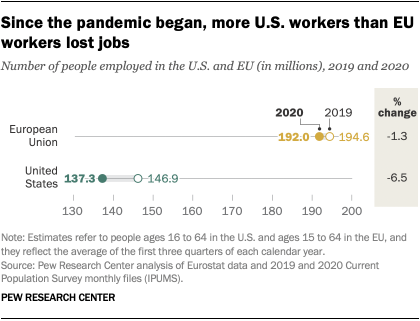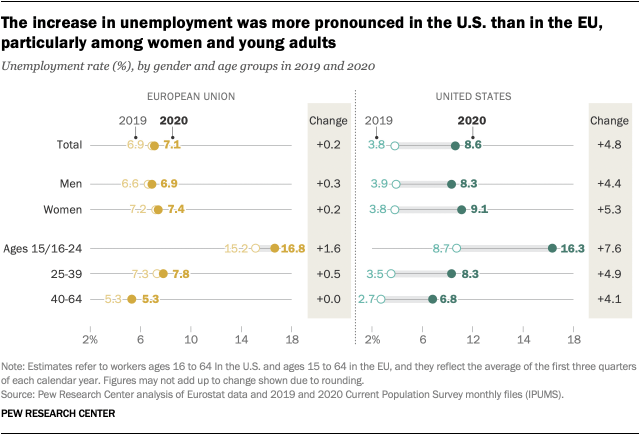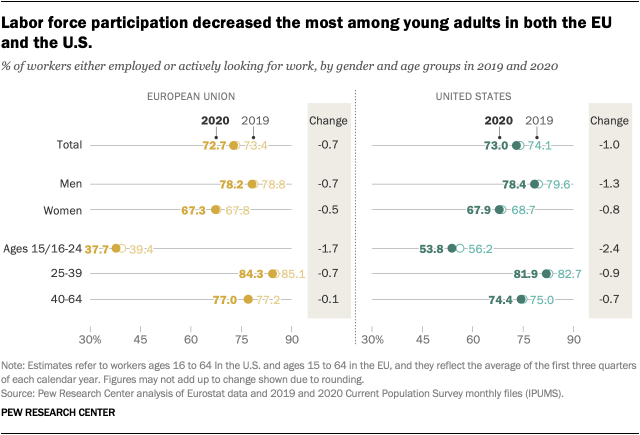The European Union and the United States have both been deeply affected by the coronavirus outbreak. The two contribute equally to the world economy, each accounting for about 16% of global output. A key difference is that the EU is home to about 100 million more people than the U.S. But Americans have lost significantly more jobs than their EU counterparts during the COVID-19 downturn.
One factor in play is that while countries across the EU deployed significant employment retention schemes, the U.S. focused on stimulus checks and unemployment compensation in lieu of job retention.
Roughly 9.6 million U.S. workers (ages 16 to 64) lost their jobs, based on averages of the first three quarters of 2019 and the first three quarters of 2020. In contrast, only about 2.6 million workers in the EU (ages 15 to 64) lost their jobs over this period, despite having a larger population. Young adults in both regions were more likely to lose jobs during the pandemic, according to a new Pew Research Center analysis of U.S. government and Eurostat data.
To compare the impact of the COVID-19 recession in the U.S. and European Union, we analyzed the latest available data from Eurostat, the statistical office of the EU and, for the U.S., data from the 2019 and 2020 Current Population Survey monthly files (IPUMS). The CPS, conducted by the U.S. Census Bureau for the Bureau of Labor Statistics, is the nation’s premier labor force survey and is the basis for the monthly national unemployment rate.
The COVID-19 outbreak has affected data collection efforts by the U.S. government in its surveys, limiting in-person data collection and affecting the response rate. It is possible that some measures of labor market activity and how they vary across demographic groups are affected by these changes in data collection. The COVID-19 outbreak has affected data collection efforts by the U.S. government in its surveys, limiting in-person data collection and affecting the response rate. It is possible that some measures of labor market activity and how they vary across demographic groups are affected by these changes in data collection.
The increase in the unemployment rate in the U.S. was greater than in the EU. In the U.S., the unemployment rate increased from 3.8% in 2019 to 8.6% in 2020, compared with an increase from 6.9% to 7.1% in the EU.
In the U.S., women saw a slightly larger increase in the unemployment rate than men from 2019 to 2020 (+5.3 percentage points and +4.4 points, respectively). In comparison, women in the EU saw their unemployment rate increase by only 0.2 percentage points from 2019 to 2020, similar to the increase for men.
Looking across age groups in the U.S., young adults ages 16 to 24 experienced the greatest increase in the unemployment rate (+7.6 percentage points vs. +4.9 points among those ages 25 to 39 and +4.1 points among those 40 to 64). While the increase in the unemployment rate among young adults in the EU (ages 15 to 24) was also more pronounced than among older adults, it was much smaller than that of young adults in the U.S. (+1.6 percentage points among those ages 15 to 24 in the EU vs. +0.5 points among those ages 25 to 39 and no net changes among those 40 to 64).
Although employment losses were more pronounced in the U.S., both regions saw roughly similar decreases in labor force participation – the share of workers who are employed or actively looking for work. Among all workers ages 16 to 64, the labor force participation rate in the U.S. fell from 74.1% in 2019 to 73.0% in 2020. In the EU, the participation rate among workers ages 15 to 64 decreased from 73.4% in 2019 to 72.7% in 2020.
In the U.S., labor force attrition was most notable among young adults ages 16 to 24, with their labor force participation rate decreasing from 56.2% in 2019 to 53.8% in 2020 (-2.4 percentage points). The decrease in participation was less pronounced among U.S. workers ages 25 to 39 and 40 to 64 (-0.9 and -0.7 points, respectively). EU workers show a similar pattern to their American counterparts, with young adults ages 15 to 24 having the largest decrease in labor force participation (-1.7 points), followed by workers ages 25 to 39 (-0.7) and 40 to 64 (-0.1).
In both the U.S. and Europe, the labor force participation rate decreased about the same amount for women and men ages 15 and 16 to 64. Among American men, the participation rate decreased 1.3 percentage points from 79.6% to 78.4%, while the rate for American women fell 0.8 points (68.7% in 2019 to 67.9% in 2020). In the EU, labor force participation declined by 0.7 percentage points among men and 0.5 points among women.


